Nursing Plan of Care for Exacerbated Congestive Heart Failure
VerifiedAdded on 2023/01/16
|11
|3154
|26
AI Summary
This document discusses the nursing plan of care for a patient with exacerbated congestive heart failure. It covers interventions for managing tachycardia, hypertension, and shortness of breath. It also provides a discharge plan for continued care at home.
Contribute Materials
Your contribution can guide someone’s learning journey. Share your
documents today.
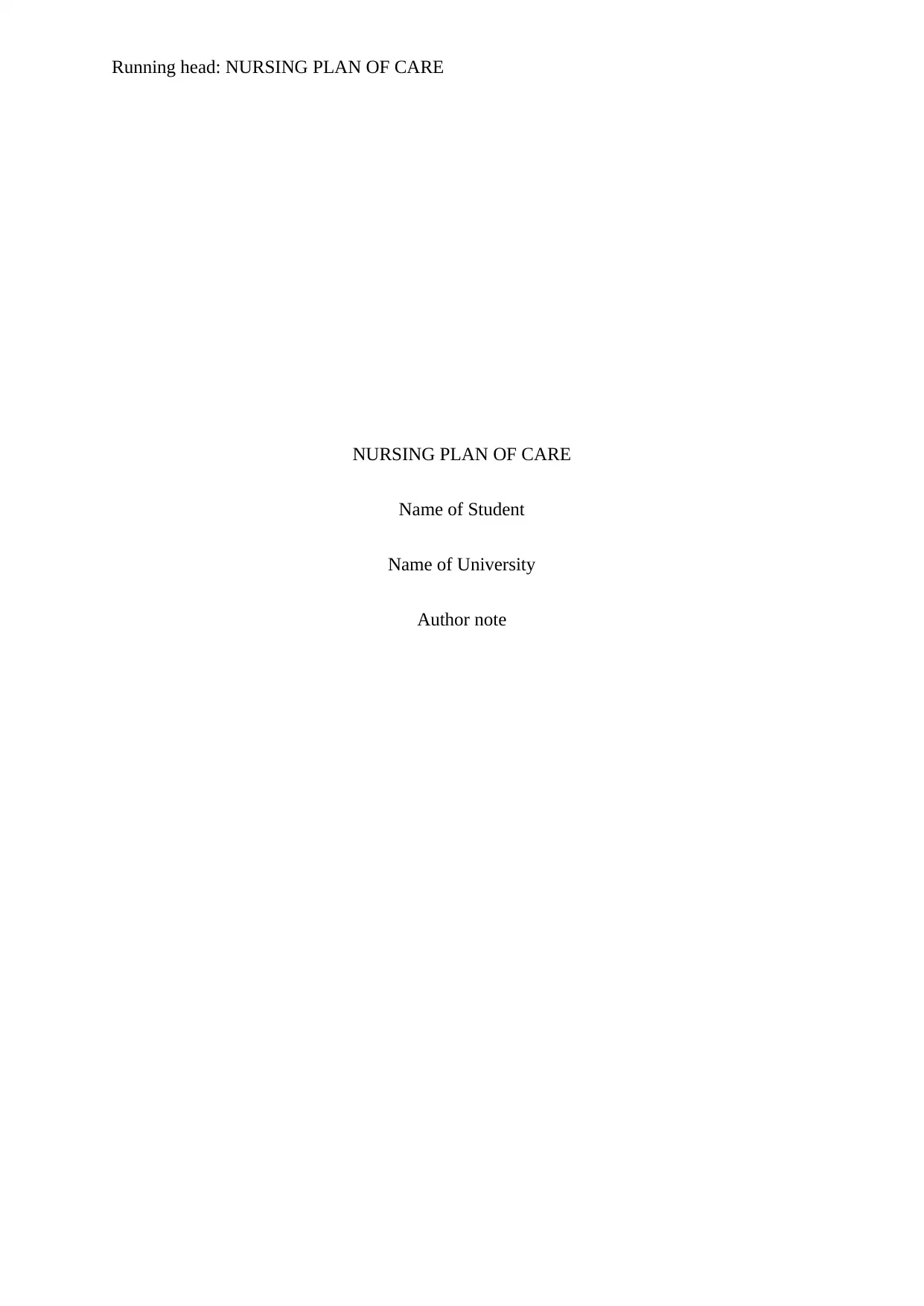
Running head: NURSING PLAN OF CARE
NURSING PLAN OF CARE
Name of Student
Name of University
Author note
NURSING PLAN OF CARE
Name of Student
Name of University
Author note
Secure Best Marks with AI Grader
Need help grading? Try our AI Grader for instant feedback on your assignments.
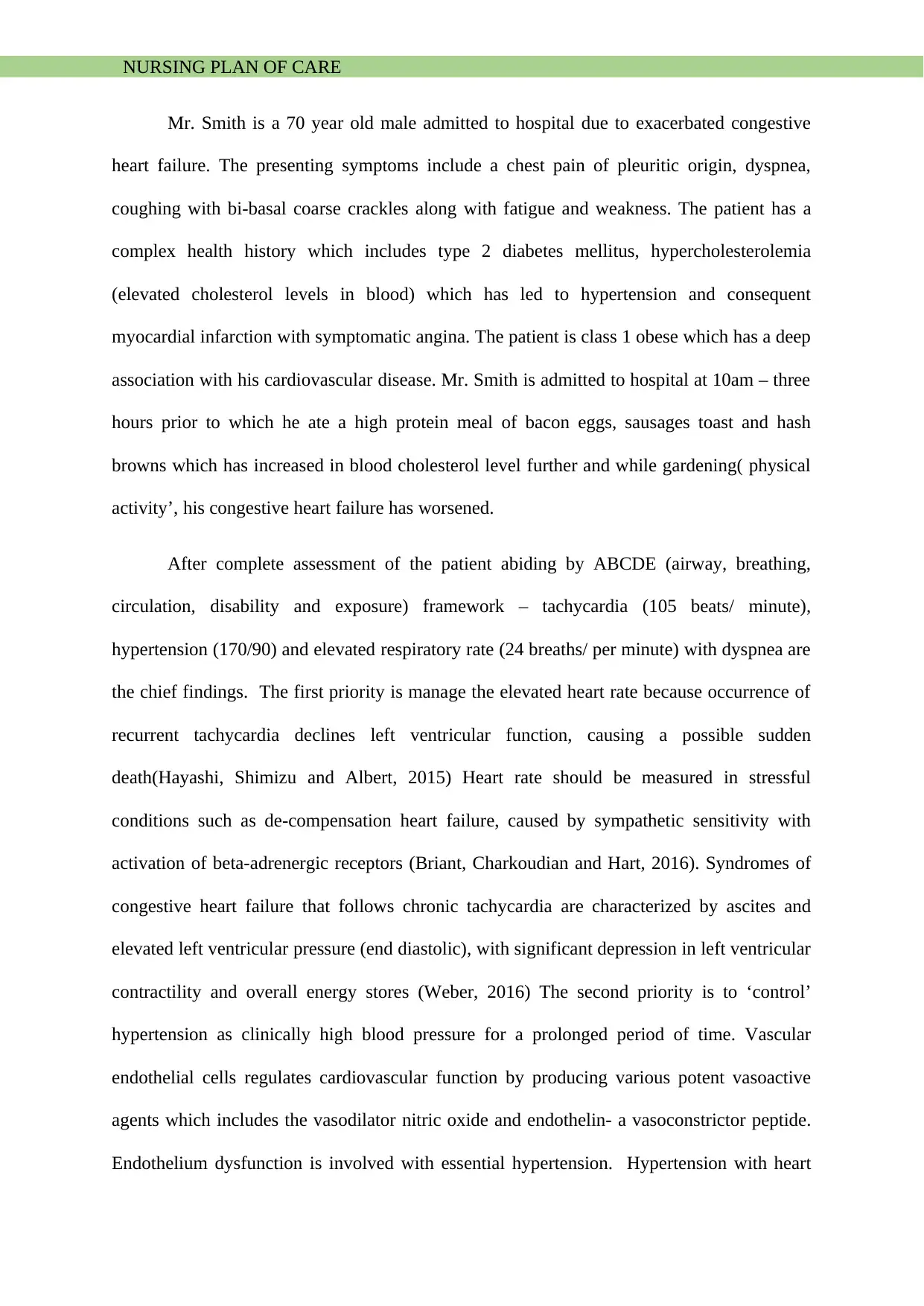
NURSING PLAN OF CARE
Mr. Smith is a 70 year old male admitted to hospital due to exacerbated congestive
heart failure. The presenting symptoms include a chest pain of pleuritic origin, dyspnea,
coughing with bi-basal coarse crackles along with fatigue and weakness. The patient has a
complex health history which includes type 2 diabetes mellitus, hypercholesterolemia
(elevated cholesterol levels in blood) which has led to hypertension and consequent
myocardial infarction with symptomatic angina. The patient is class 1 obese which has a deep
association with his cardiovascular disease. Mr. Smith is admitted to hospital at 10am – three
hours prior to which he ate a high protein meal of bacon eggs, sausages toast and hash
browns which has increased in blood cholesterol level further and while gardening( physical
activity’, his congestive heart failure has worsened.
After complete assessment of the patient abiding by ABCDE (airway, breathing,
circulation, disability and exposure) framework – tachycardia (105 beats/ minute),
hypertension (170/90) and elevated respiratory rate (24 breaths/ per minute) with dyspnea are
the chief findings. The first priority is manage the elevated heart rate because occurrence of
recurrent tachycardia declines left ventricular function, causing a possible sudden
death(Hayashi, Shimizu and Albert, 2015) Heart rate should be measured in stressful
conditions such as de-compensation heart failure, caused by sympathetic sensitivity with
activation of beta-adrenergic receptors (Briant, Charkoudian and Hart, 2016). Syndromes of
congestive heart failure that follows chronic tachycardia are characterized by ascites and
elevated left ventricular pressure (end diastolic), with significant depression in left ventricular
contractility and overall energy stores (Weber, 2016) The second priority is to ‘control’
hypertension as clinically high blood pressure for a prolonged period of time. Vascular
endothelial cells regulates cardiovascular function by producing various potent vasoactive
agents which includes the vasodilator nitric oxide and endothelin- a vasoconstrictor peptide.
Endothelium dysfunction is involved with essential hypertension. Hypertension with heart
Mr. Smith is a 70 year old male admitted to hospital due to exacerbated congestive
heart failure. The presenting symptoms include a chest pain of pleuritic origin, dyspnea,
coughing with bi-basal coarse crackles along with fatigue and weakness. The patient has a
complex health history which includes type 2 diabetes mellitus, hypercholesterolemia
(elevated cholesterol levels in blood) which has led to hypertension and consequent
myocardial infarction with symptomatic angina. The patient is class 1 obese which has a deep
association with his cardiovascular disease. Mr. Smith is admitted to hospital at 10am – three
hours prior to which he ate a high protein meal of bacon eggs, sausages toast and hash
browns which has increased in blood cholesterol level further and while gardening( physical
activity’, his congestive heart failure has worsened.
After complete assessment of the patient abiding by ABCDE (airway, breathing,
circulation, disability and exposure) framework – tachycardia (105 beats/ minute),
hypertension (170/90) and elevated respiratory rate (24 breaths/ per minute) with dyspnea are
the chief findings. The first priority is manage the elevated heart rate because occurrence of
recurrent tachycardia declines left ventricular function, causing a possible sudden
death(Hayashi, Shimizu and Albert, 2015) Heart rate should be measured in stressful
conditions such as de-compensation heart failure, caused by sympathetic sensitivity with
activation of beta-adrenergic receptors (Briant, Charkoudian and Hart, 2016). Syndromes of
congestive heart failure that follows chronic tachycardia are characterized by ascites and
elevated left ventricular pressure (end diastolic), with significant depression in left ventricular
contractility and overall energy stores (Weber, 2016) The second priority is to ‘control’
hypertension as clinically high blood pressure for a prolonged period of time. Vascular
endothelial cells regulates cardiovascular function by producing various potent vasoactive
agents which includes the vasodilator nitric oxide and endothelin- a vasoconstrictor peptide.
Endothelium dysfunction is involved with essential hypertension. Hypertension with heart
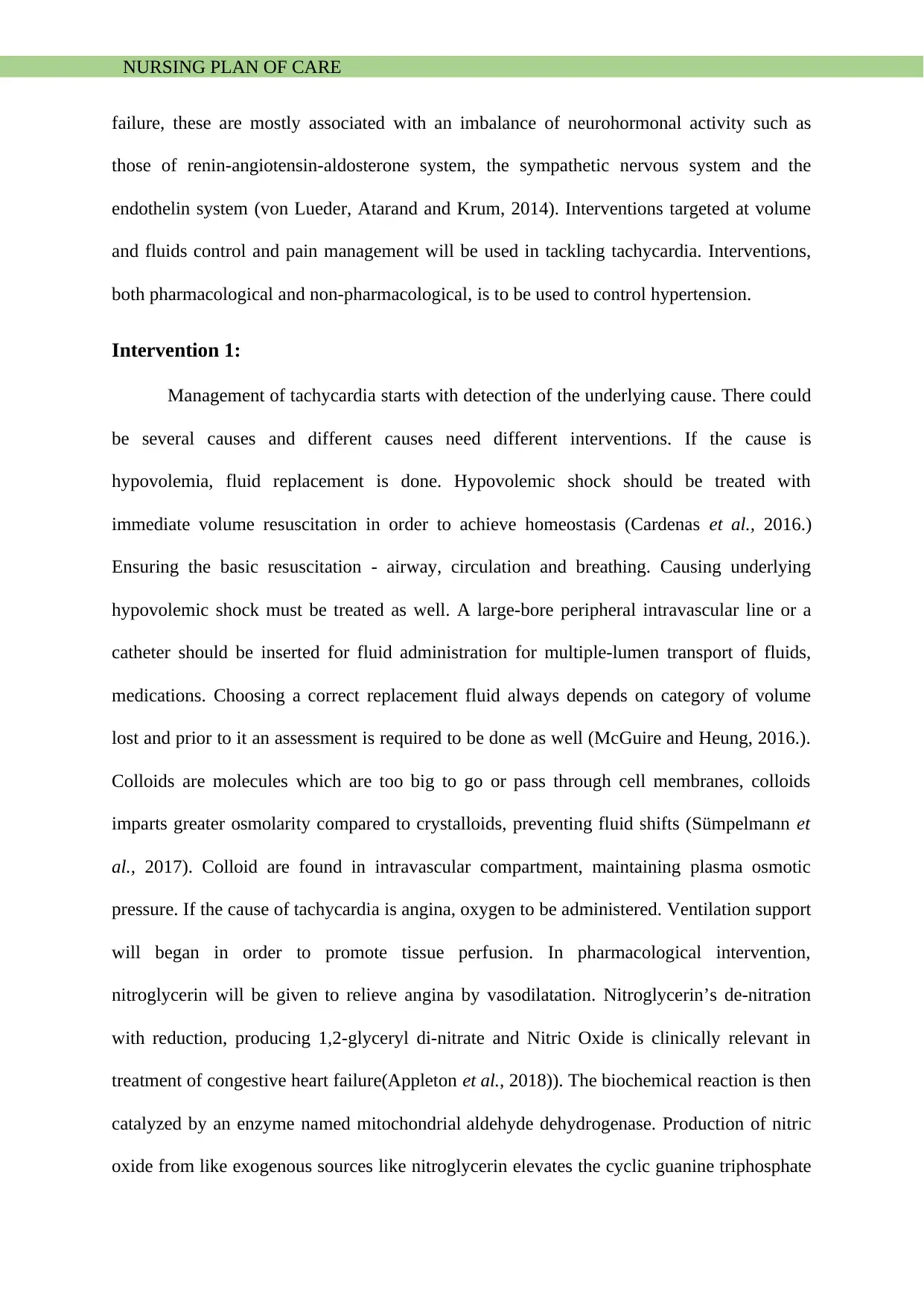
NURSING PLAN OF CARE
failure, these are mostly associated with an imbalance of neurohormonal activity such as
those of renin-angiotensin-aldosterone system, the sympathetic nervous system and the
endothelin system (von Lueder, Atarand and Krum, 2014). Interventions targeted at volume
and fluids control and pain management will be used in tackling tachycardia. Interventions,
both pharmacological and non-pharmacological, is to be used to control hypertension.
Intervention 1:
Management of tachycardia starts with detection of the underlying cause. There could
be several causes and different causes need different interventions. If the cause is
hypovolemia, fluid replacement is done. Hypovolemic shock should be treated with
immediate volume resuscitation in order to achieve homeostasis (Cardenas et al., 2016.)
Ensuring the basic resuscitation - airway, circulation and breathing. Causing underlying
hypovolemic shock must be treated as well. A large-bore peripheral intravascular line or a
catheter should be inserted for fluid administration for multiple-lumen transport of fluids,
medications. Choosing a correct replacement fluid always depends on category of volume
lost and prior to it an assessment is required to be done as well (McGuire and Heung, 2016.).
Colloids are molecules which are too big to go or pass through cell membranes, colloids
imparts greater osmolarity compared to crystalloids, preventing fluid shifts (Sümpelmann et
al., 2017). Colloid are found in intravascular compartment, maintaining plasma osmotic
pressure. If the cause of tachycardia is angina, oxygen to be administered. Ventilation support
will began in order to promote tissue perfusion. In pharmacological intervention,
nitroglycerin will be given to relieve angina by vasodilatation. Nitroglycerin’s de-nitration
with reduction, producing 1,2-glyceryl di-nitrate and Nitric Oxide is clinically relevant in
treatment of congestive heart failure(Appleton et al., 2018)). The biochemical reaction is then
catalyzed by an enzyme named mitochondrial aldehyde dehydrogenase. Production of nitric
oxide from like exogenous sources like nitroglycerin elevates the cyclic guanine triphosphate
failure, these are mostly associated with an imbalance of neurohormonal activity such as
those of renin-angiotensin-aldosterone system, the sympathetic nervous system and the
endothelin system (von Lueder, Atarand and Krum, 2014). Interventions targeted at volume
and fluids control and pain management will be used in tackling tachycardia. Interventions,
both pharmacological and non-pharmacological, is to be used to control hypertension.
Intervention 1:
Management of tachycardia starts with detection of the underlying cause. There could
be several causes and different causes need different interventions. If the cause is
hypovolemia, fluid replacement is done. Hypovolemic shock should be treated with
immediate volume resuscitation in order to achieve homeostasis (Cardenas et al., 2016.)
Ensuring the basic resuscitation - airway, circulation and breathing. Causing underlying
hypovolemic shock must be treated as well. A large-bore peripheral intravascular line or a
catheter should be inserted for fluid administration for multiple-lumen transport of fluids,
medications. Choosing a correct replacement fluid always depends on category of volume
lost and prior to it an assessment is required to be done as well (McGuire and Heung, 2016.).
Colloids are molecules which are too big to go or pass through cell membranes, colloids
imparts greater osmolarity compared to crystalloids, preventing fluid shifts (Sümpelmann et
al., 2017). Colloid are found in intravascular compartment, maintaining plasma osmotic
pressure. If the cause of tachycardia is angina, oxygen to be administered. Ventilation support
will began in order to promote tissue perfusion. In pharmacological intervention,
nitroglycerin will be given to relieve angina by vasodilatation. Nitroglycerin’s de-nitration
with reduction, producing 1,2-glyceryl di-nitrate and Nitric Oxide is clinically relevant in
treatment of congestive heart failure(Appleton et al., 2018)). The biochemical reaction is then
catalyzed by an enzyme named mitochondrial aldehyde dehydrogenase. Production of nitric
oxide from like exogenous sources like nitroglycerin elevates the cyclic guanine triphosphate
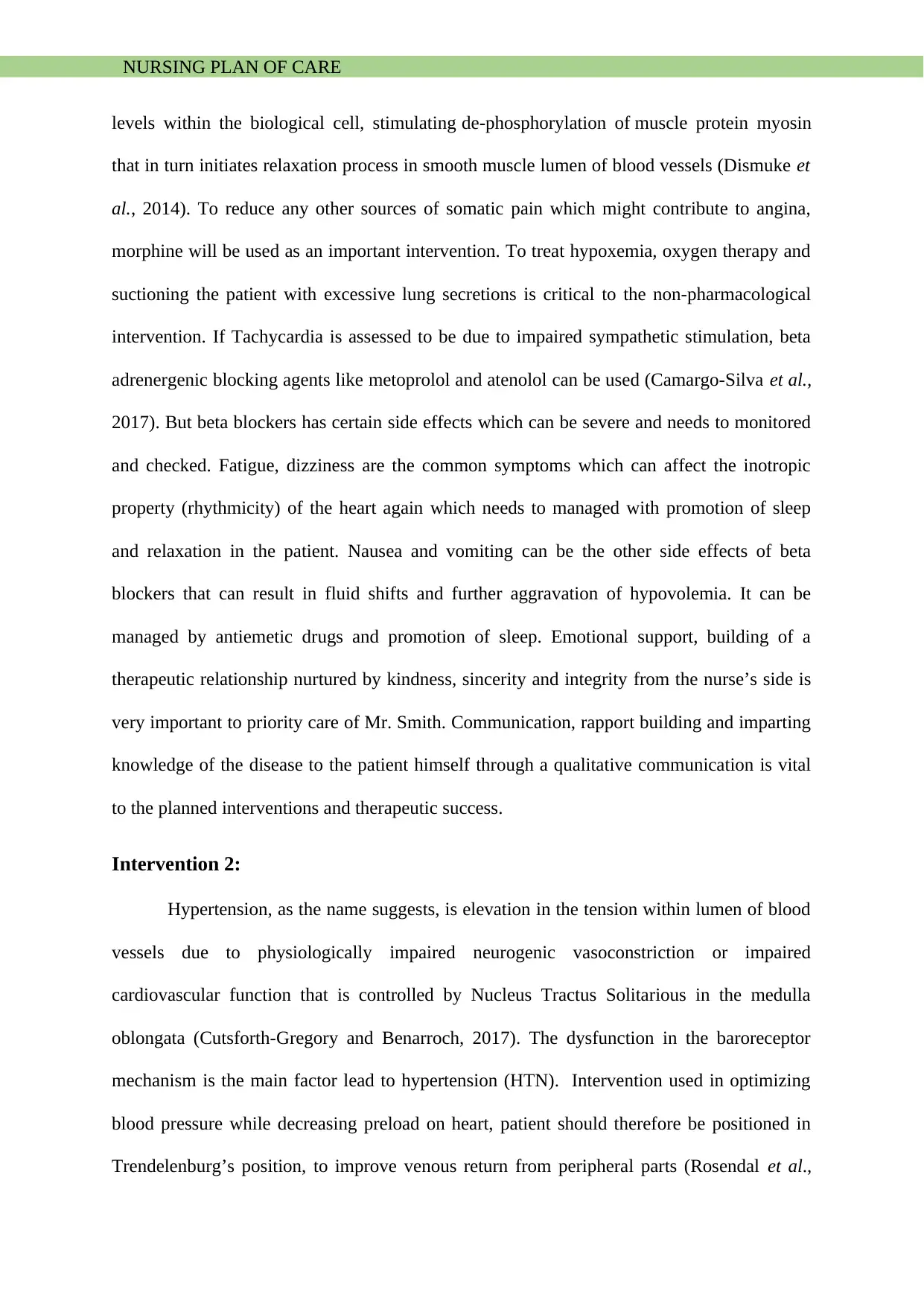
NURSING PLAN OF CARE
levels within the biological cell, stimulating de-phosphorylation of muscle protein myosin
that in turn initiates relaxation process in smooth muscle lumen of blood vessels (Dismuke et
al., 2014). To reduce any other sources of somatic pain which might contribute to angina,
morphine will be used as an important intervention. To treat hypoxemia, oxygen therapy and
suctioning the patient with excessive lung secretions is critical to the non-pharmacological
intervention. If Tachycardia is assessed to be due to impaired sympathetic stimulation, beta
adrenergenic blocking agents like metoprolol and atenolol can be used (Camargo-Silva et al.,
2017). But beta blockers has certain side effects which can be severe and needs to monitored
and checked. Fatigue, dizziness are the common symptoms which can affect the inotropic
property (rhythmicity) of the heart again which needs to managed with promotion of sleep
and relaxation in the patient. Nausea and vomiting can be the other side effects of beta
blockers that can result in fluid shifts and further aggravation of hypovolemia. It can be
managed by antiemetic drugs and promotion of sleep. Emotional support, building of a
therapeutic relationship nurtured by kindness, sincerity and integrity from the nurse’s side is
very important to priority care of Mr. Smith. Communication, rapport building and imparting
knowledge of the disease to the patient himself through a qualitative communication is vital
to the planned interventions and therapeutic success.
Intervention 2:
Hypertension, as the name suggests, is elevation in the tension within lumen of blood
vessels due to physiologically impaired neurogenic vasoconstriction or impaired
cardiovascular function that is controlled by Nucleus Tractus Solitarious in the medulla
oblongata (Cutsforth-Gregory and Benarroch, 2017). The dysfunction in the baroreceptor
mechanism is the main factor lead to hypertension (HTN). Intervention used in optimizing
blood pressure while decreasing preload on heart, patient should therefore be positioned in
Trendelenburg’s position, to improve venous return from peripheral parts (Rosendal et al.,
levels within the biological cell, stimulating de-phosphorylation of muscle protein myosin
that in turn initiates relaxation process in smooth muscle lumen of blood vessels (Dismuke et
al., 2014). To reduce any other sources of somatic pain which might contribute to angina,
morphine will be used as an important intervention. To treat hypoxemia, oxygen therapy and
suctioning the patient with excessive lung secretions is critical to the non-pharmacological
intervention. If Tachycardia is assessed to be due to impaired sympathetic stimulation, beta
adrenergenic blocking agents like metoprolol and atenolol can be used (Camargo-Silva et al.,
2017). But beta blockers has certain side effects which can be severe and needs to monitored
and checked. Fatigue, dizziness are the common symptoms which can affect the inotropic
property (rhythmicity) of the heart again which needs to managed with promotion of sleep
and relaxation in the patient. Nausea and vomiting can be the other side effects of beta
blockers that can result in fluid shifts and further aggravation of hypovolemia. It can be
managed by antiemetic drugs and promotion of sleep. Emotional support, building of a
therapeutic relationship nurtured by kindness, sincerity and integrity from the nurse’s side is
very important to priority care of Mr. Smith. Communication, rapport building and imparting
knowledge of the disease to the patient himself through a qualitative communication is vital
to the planned interventions and therapeutic success.
Intervention 2:
Hypertension, as the name suggests, is elevation in the tension within lumen of blood
vessels due to physiologically impaired neurogenic vasoconstriction or impaired
cardiovascular function that is controlled by Nucleus Tractus Solitarious in the medulla
oblongata (Cutsforth-Gregory and Benarroch, 2017). The dysfunction in the baroreceptor
mechanism is the main factor lead to hypertension (HTN). Intervention used in optimizing
blood pressure while decreasing preload on heart, patient should therefore be positioned in
Trendelenburg’s position, to improve venous return from peripheral parts (Rosendal et al.,
Secure Best Marks with AI Grader
Need help grading? Try our AI Grader for instant feedback on your assignments.
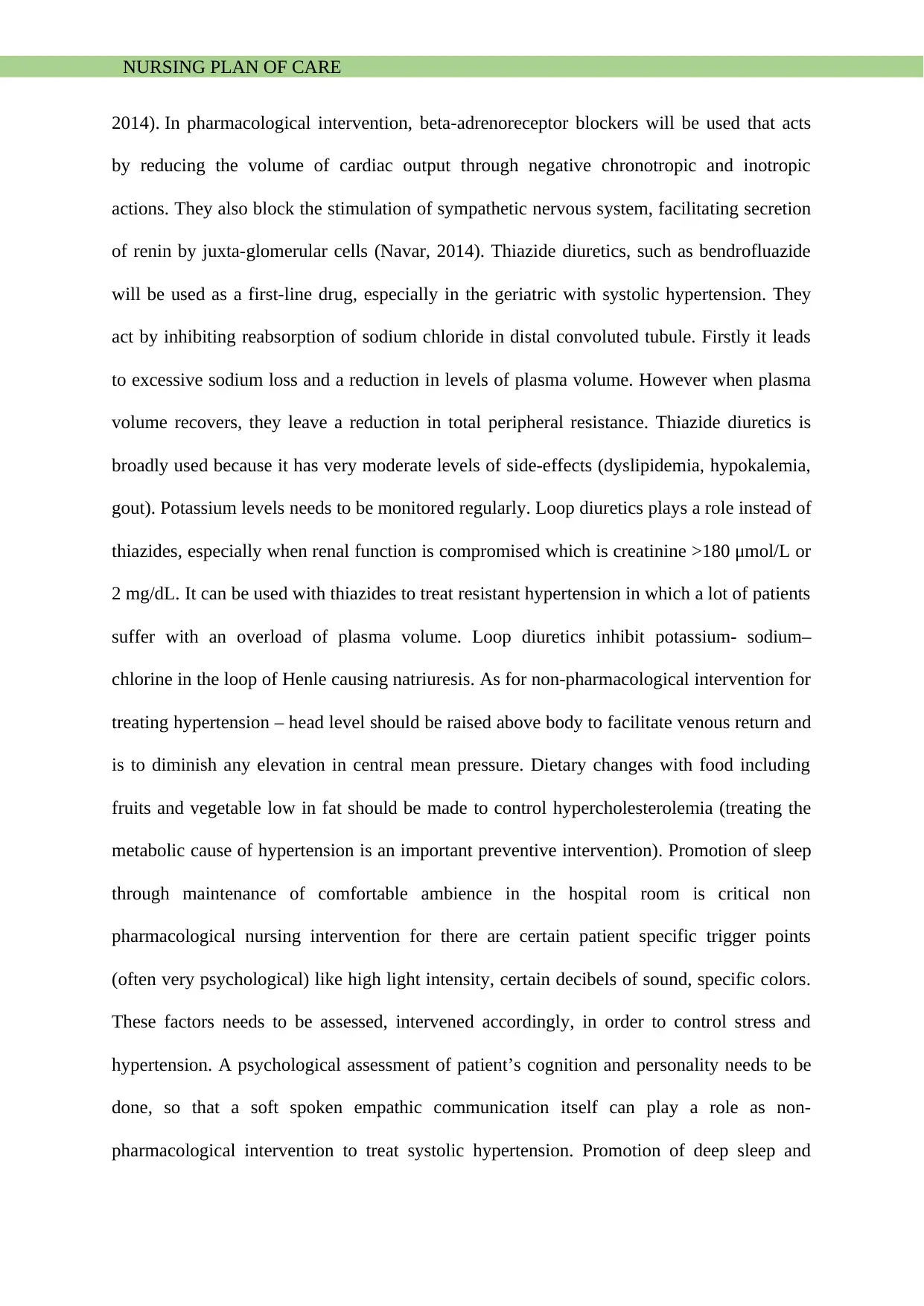
NURSING PLAN OF CARE
2014). In pharmacological intervention, beta-adrenoreceptor blockers will be used that acts
by reducing the volume of cardiac output through negative chronotropic and inotropic
actions. They also block the stimulation of sympathetic nervous system, facilitating secretion
of renin by juxta-glomerular cells (Navar, 2014). Thiazide diuretics, such as bendrofluazide
will be used as a first-line drug, especially in the geriatric with systolic hypertension. They
act by inhibiting reabsorption of sodium chloride in distal convoluted tubule. Firstly it leads
to excessive sodium loss and a reduction in levels of plasma volume. However when plasma
volume recovers, they leave a reduction in total peripheral resistance. Thiazide diuretics is
broadly used because it has very moderate levels of side-effects (dyslipidemia, hypokalemia,
gout). Potassium levels needs to be monitored regularly. Loop diuretics plays a role instead of
thiazides, especially when renal function is compromised which is creatinine >180 μmol/L or
2 mg/dL. It can be used with thiazides to treat resistant hypertension in which a lot of patients
suffer with an overload of plasma volume. Loop diuretics inhibit potassium- sodium–
chlorine in the loop of Henle causing natriuresis. As for non-pharmacological intervention for
treating hypertension – head level should be raised above body to facilitate venous return and
is to diminish any elevation in central mean pressure. Dietary changes with food including
fruits and vegetable low in fat should be made to control hypercholesterolemia (treating the
metabolic cause of hypertension is an important preventive intervention). Promotion of sleep
through maintenance of comfortable ambience in the hospital room is critical non
pharmacological nursing intervention for there are certain patient specific trigger points
(often very psychological) like high light intensity, certain decibels of sound, specific colors.
These factors needs to be assessed, intervened accordingly, in order to control stress and
hypertension. A psychological assessment of patient’s cognition and personality needs to be
done, so that a soft spoken empathic communication itself can play a role as non-
pharmacological intervention to treat systolic hypertension. Promotion of deep sleep and
2014). In pharmacological intervention, beta-adrenoreceptor blockers will be used that acts
by reducing the volume of cardiac output through negative chronotropic and inotropic
actions. They also block the stimulation of sympathetic nervous system, facilitating secretion
of renin by juxta-glomerular cells (Navar, 2014). Thiazide diuretics, such as bendrofluazide
will be used as a first-line drug, especially in the geriatric with systolic hypertension. They
act by inhibiting reabsorption of sodium chloride in distal convoluted tubule. Firstly it leads
to excessive sodium loss and a reduction in levels of plasma volume. However when plasma
volume recovers, they leave a reduction in total peripheral resistance. Thiazide diuretics is
broadly used because it has very moderate levels of side-effects (dyslipidemia, hypokalemia,
gout). Potassium levels needs to be monitored regularly. Loop diuretics plays a role instead of
thiazides, especially when renal function is compromised which is creatinine >180 μmol/L or
2 mg/dL. It can be used with thiazides to treat resistant hypertension in which a lot of patients
suffer with an overload of plasma volume. Loop diuretics inhibit potassium- sodium–
chlorine in the loop of Henle causing natriuresis. As for non-pharmacological intervention for
treating hypertension – head level should be raised above body to facilitate venous return and
is to diminish any elevation in central mean pressure. Dietary changes with food including
fruits and vegetable low in fat should be made to control hypercholesterolemia (treating the
metabolic cause of hypertension is an important preventive intervention). Promotion of sleep
through maintenance of comfortable ambience in the hospital room is critical non
pharmacological nursing intervention for there are certain patient specific trigger points
(often very psychological) like high light intensity, certain decibels of sound, specific colors.
These factors needs to be assessed, intervened accordingly, in order to control stress and
hypertension. A psychological assessment of patient’s cognition and personality needs to be
done, so that a soft spoken empathic communication itself can play a role as non-
pharmacological intervention to treat systolic hypertension. Promotion of deep sleep and
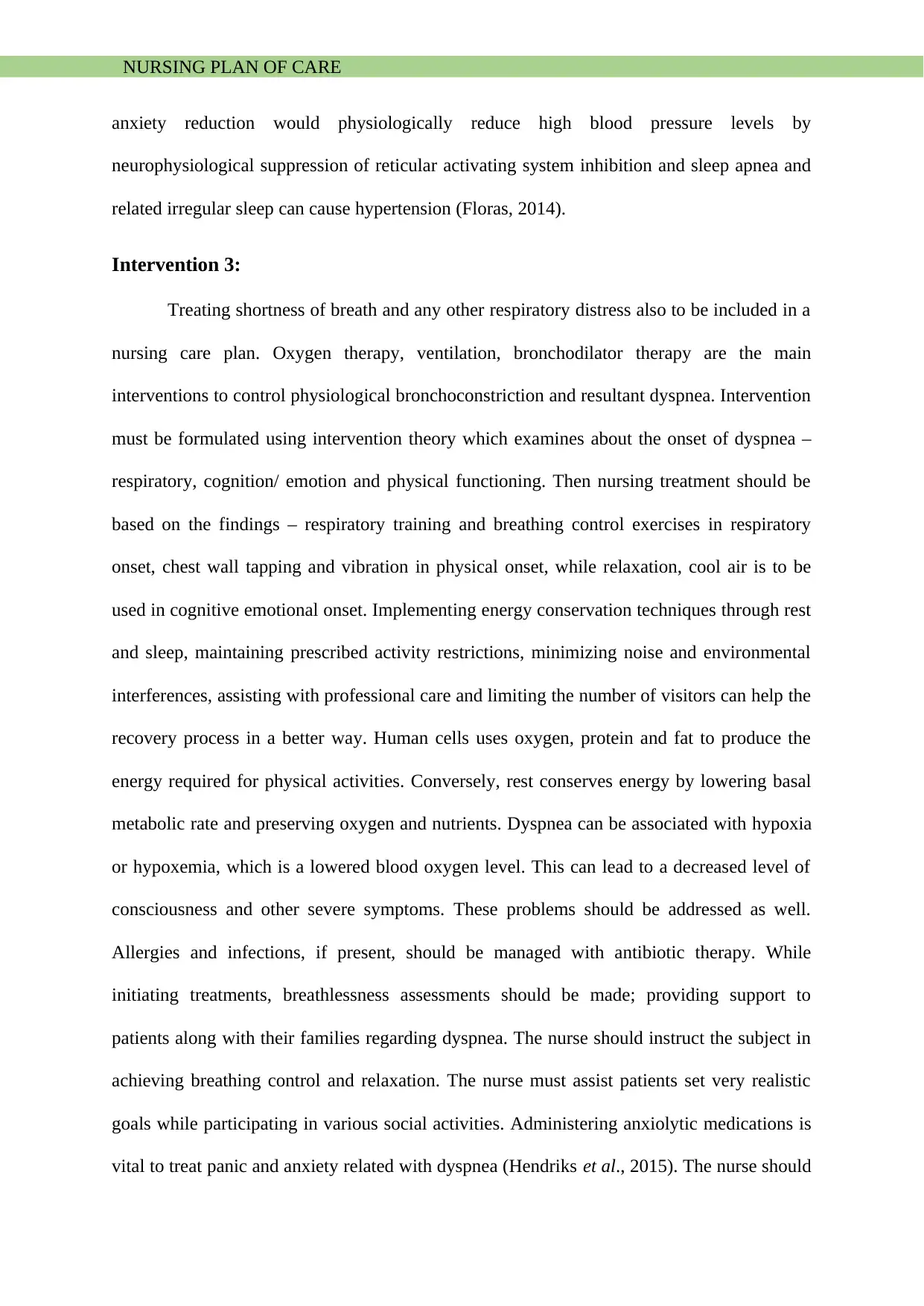
NURSING PLAN OF CARE
anxiety reduction would physiologically reduce high blood pressure levels by
neurophysiological suppression of reticular activating system inhibition and sleep apnea and
related irregular sleep can cause hypertension (Floras, 2014).
Intervention 3:
Treating shortness of breath and any other respiratory distress also to be included in a
nursing care plan. Oxygen therapy, ventilation, bronchodilator therapy are the main
interventions to control physiological bronchoconstriction and resultant dyspnea. Intervention
must be formulated using intervention theory which examines about the onset of dyspnea –
respiratory, cognition/ emotion and physical functioning. Then nursing treatment should be
based on the findings – respiratory training and breathing control exercises in respiratory
onset, chest wall tapping and vibration in physical onset, while relaxation, cool air is to be
used in cognitive emotional onset. Implementing energy conservation techniques through rest
and sleep, maintaining prescribed activity restrictions, minimizing noise and environmental
interferences, assisting with professional care and limiting the number of visitors can help the
recovery process in a better way. Human cells uses oxygen, protein and fat to produce the
energy required for physical activities. Conversely, rest conserves energy by lowering basal
metabolic rate and preserving oxygen and nutrients. Dyspnea can be associated with hypoxia
or hypoxemia, which is a lowered blood oxygen level. This can lead to a decreased level of
consciousness and other severe symptoms. These problems should be addressed as well.
Allergies and infections, if present, should be managed with antibiotic therapy. While
initiating treatments, breathlessness assessments should be made; providing support to
patients along with their families regarding dyspnea. The nurse should instruct the subject in
achieving breathing control and relaxation. The nurse must assist patients set very realistic
goals while participating in various social activities. Administering anxiolytic medications is
vital to treat panic and anxiety related with dyspnea (Hendriks et al., 2015). The nurse should
anxiety reduction would physiologically reduce high blood pressure levels by
neurophysiological suppression of reticular activating system inhibition and sleep apnea and
related irregular sleep can cause hypertension (Floras, 2014).
Intervention 3:
Treating shortness of breath and any other respiratory distress also to be included in a
nursing care plan. Oxygen therapy, ventilation, bronchodilator therapy are the main
interventions to control physiological bronchoconstriction and resultant dyspnea. Intervention
must be formulated using intervention theory which examines about the onset of dyspnea –
respiratory, cognition/ emotion and physical functioning. Then nursing treatment should be
based on the findings – respiratory training and breathing control exercises in respiratory
onset, chest wall tapping and vibration in physical onset, while relaxation, cool air is to be
used in cognitive emotional onset. Implementing energy conservation techniques through rest
and sleep, maintaining prescribed activity restrictions, minimizing noise and environmental
interferences, assisting with professional care and limiting the number of visitors can help the
recovery process in a better way. Human cells uses oxygen, protein and fat to produce the
energy required for physical activities. Conversely, rest conserves energy by lowering basal
metabolic rate and preserving oxygen and nutrients. Dyspnea can be associated with hypoxia
or hypoxemia, which is a lowered blood oxygen level. This can lead to a decreased level of
consciousness and other severe symptoms. These problems should be addressed as well.
Allergies and infections, if present, should be managed with antibiotic therapy. While
initiating treatments, breathlessness assessments should be made; providing support to
patients along with their families regarding dyspnea. The nurse should instruct the subject in
achieving breathing control and relaxation. The nurse must assist patients set very realistic
goals while participating in various social activities. Administering anxiolytic medications is
vital to treat panic and anxiety related with dyspnea (Hendriks et al., 2015). The nurse should
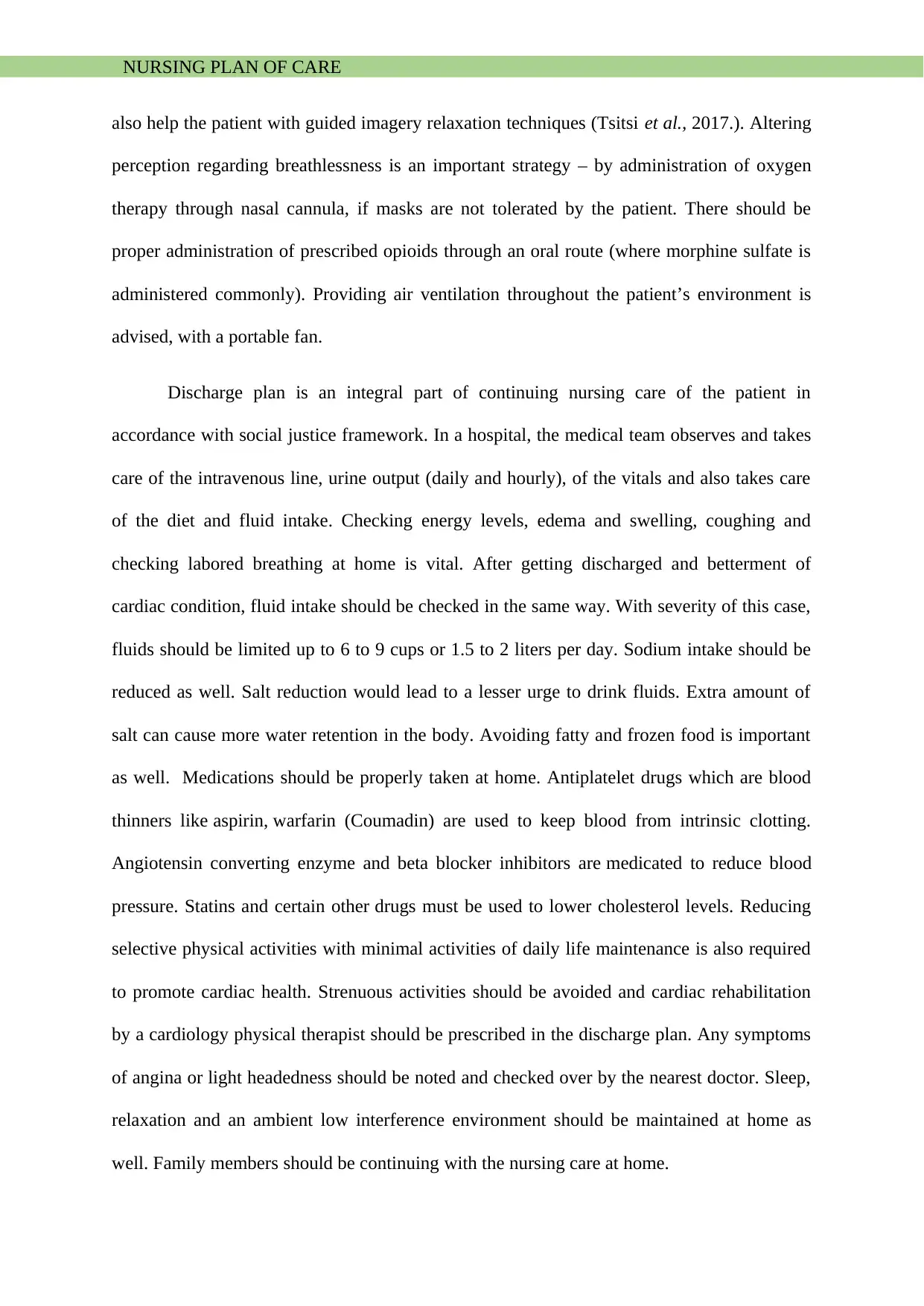
NURSING PLAN OF CARE
also help the patient with guided imagery relaxation techniques (Tsitsi et al., 2017.). Altering
perception regarding breathlessness is an important strategy – by administration of oxygen
therapy through nasal cannula, if masks are not tolerated by the patient. There should be
proper administration of prescribed opioids through an oral route (where morphine sulfate is
administered commonly). Providing air ventilation throughout the patient’s environment is
advised, with a portable fan.
Discharge plan is an integral part of continuing nursing care of the patient in
accordance with social justice framework. In a hospital, the medical team observes and takes
care of the intravenous line, urine output (daily and hourly), of the vitals and also takes care
of the diet and fluid intake. Checking energy levels, edema and swelling, coughing and
checking labored breathing at home is vital. After getting discharged and betterment of
cardiac condition, fluid intake should be checked in the same way. With severity of this case,
fluids should be limited up to 6 to 9 cups or 1.5 to 2 liters per day. Sodium intake should be
reduced as well. Salt reduction would lead to a lesser urge to drink fluids. Extra amount of
salt can cause more water retention in the body. Avoiding fatty and frozen food is important
as well. Medications should be properly taken at home. Antiplatelet drugs which are blood
thinners like aspirin, warfarin (Coumadin) are used to keep blood from intrinsic clotting.
Angiotensin converting enzyme and beta blocker inhibitors are medicated to reduce blood
pressure. Statins and certain other drugs must be used to lower cholesterol levels. Reducing
selective physical activities with minimal activities of daily life maintenance is also required
to promote cardiac health. Strenuous activities should be avoided and cardiac rehabilitation
by a cardiology physical therapist should be prescribed in the discharge plan. Any symptoms
of angina or light headedness should be noted and checked over by the nearest doctor. Sleep,
relaxation and an ambient low interference environment should be maintained at home as
well. Family members should be continuing with the nursing care at home.
also help the patient with guided imagery relaxation techniques (Tsitsi et al., 2017.). Altering
perception regarding breathlessness is an important strategy – by administration of oxygen
therapy through nasal cannula, if masks are not tolerated by the patient. There should be
proper administration of prescribed opioids through an oral route (where morphine sulfate is
administered commonly). Providing air ventilation throughout the patient’s environment is
advised, with a portable fan.
Discharge plan is an integral part of continuing nursing care of the patient in
accordance with social justice framework. In a hospital, the medical team observes and takes
care of the intravenous line, urine output (daily and hourly), of the vitals and also takes care
of the diet and fluid intake. Checking energy levels, edema and swelling, coughing and
checking labored breathing at home is vital. After getting discharged and betterment of
cardiac condition, fluid intake should be checked in the same way. With severity of this case,
fluids should be limited up to 6 to 9 cups or 1.5 to 2 liters per day. Sodium intake should be
reduced as well. Salt reduction would lead to a lesser urge to drink fluids. Extra amount of
salt can cause more water retention in the body. Avoiding fatty and frozen food is important
as well. Medications should be properly taken at home. Antiplatelet drugs which are blood
thinners like aspirin, warfarin (Coumadin) are used to keep blood from intrinsic clotting.
Angiotensin converting enzyme and beta blocker inhibitors are medicated to reduce blood
pressure. Statins and certain other drugs must be used to lower cholesterol levels. Reducing
selective physical activities with minimal activities of daily life maintenance is also required
to promote cardiac health. Strenuous activities should be avoided and cardiac rehabilitation
by a cardiology physical therapist should be prescribed in the discharge plan. Any symptoms
of angina or light headedness should be noted and checked over by the nearest doctor. Sleep,
relaxation and an ambient low interference environment should be maintained at home as
well. Family members should be continuing with the nursing care at home.
Paraphrase This Document
Need a fresh take? Get an instant paraphrase of this document with our AI Paraphraser
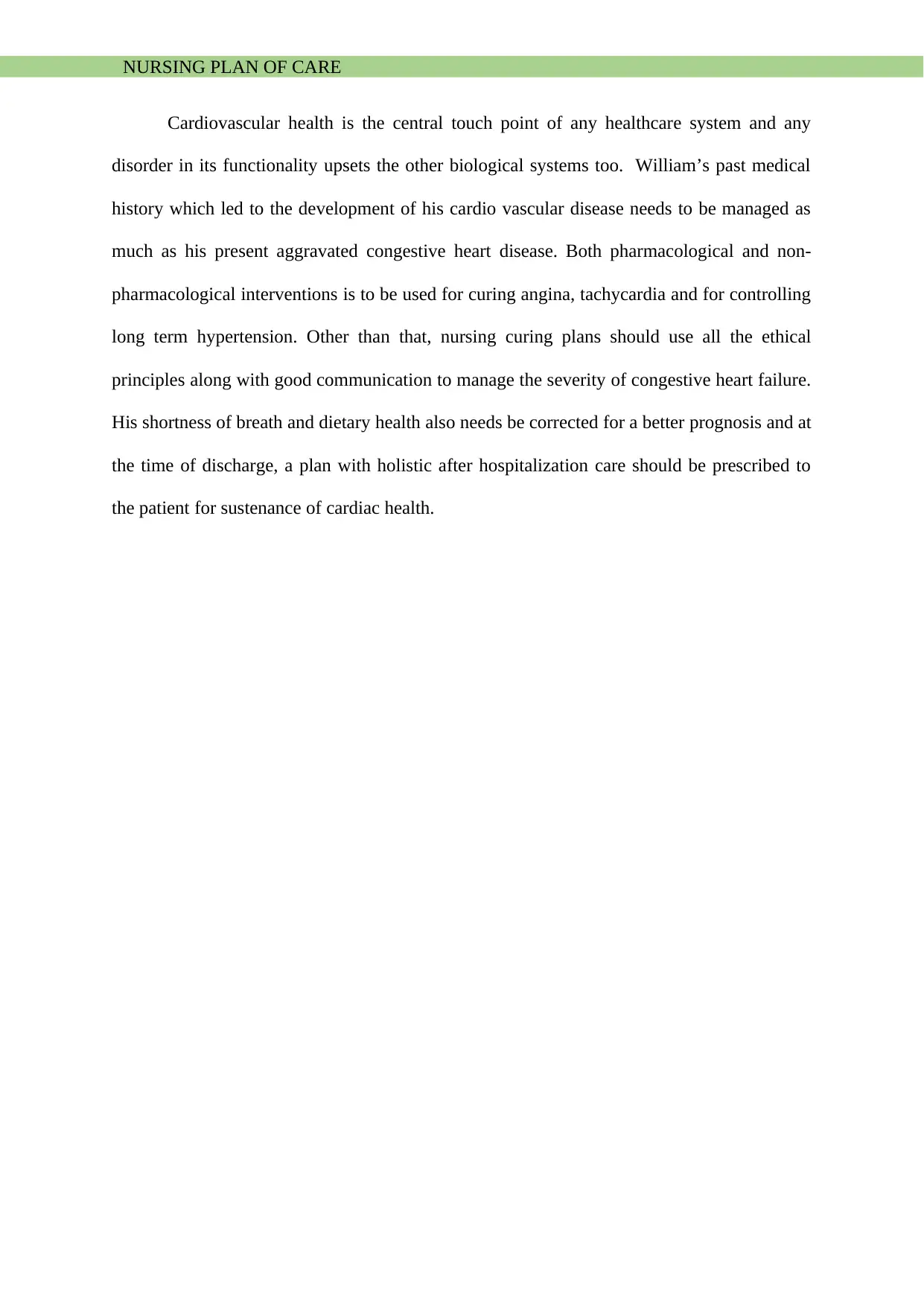
NURSING PLAN OF CARE
Cardiovascular health is the central touch point of any healthcare system and any
disorder in its functionality upsets the other biological systems too. William’s past medical
history which led to the development of his cardio vascular disease needs to be managed as
much as his present aggravated congestive heart disease. Both pharmacological and non-
pharmacological interventions is to be used for curing angina, tachycardia and for controlling
long term hypertension. Other than that, nursing curing plans should use all the ethical
principles along with good communication to manage the severity of congestive heart failure.
His shortness of breath and dietary health also needs be corrected for a better prognosis and at
the time of discharge, a plan with holistic after hospitalization care should be prescribed to
the patient for sustenance of cardiac health.
Cardiovascular health is the central touch point of any healthcare system and any
disorder in its functionality upsets the other biological systems too. William’s past medical
history which led to the development of his cardio vascular disease needs to be managed as
much as his present aggravated congestive heart disease. Both pharmacological and non-
pharmacological interventions is to be used for curing angina, tachycardia and for controlling
long term hypertension. Other than that, nursing curing plans should use all the ethical
principles along with good communication to manage the severity of congestive heart failure.
His shortness of breath and dietary health also needs be corrected for a better prognosis and at
the time of discharge, a plan with holistic after hospitalization care should be prescribed to
the patient for sustenance of cardiac health.
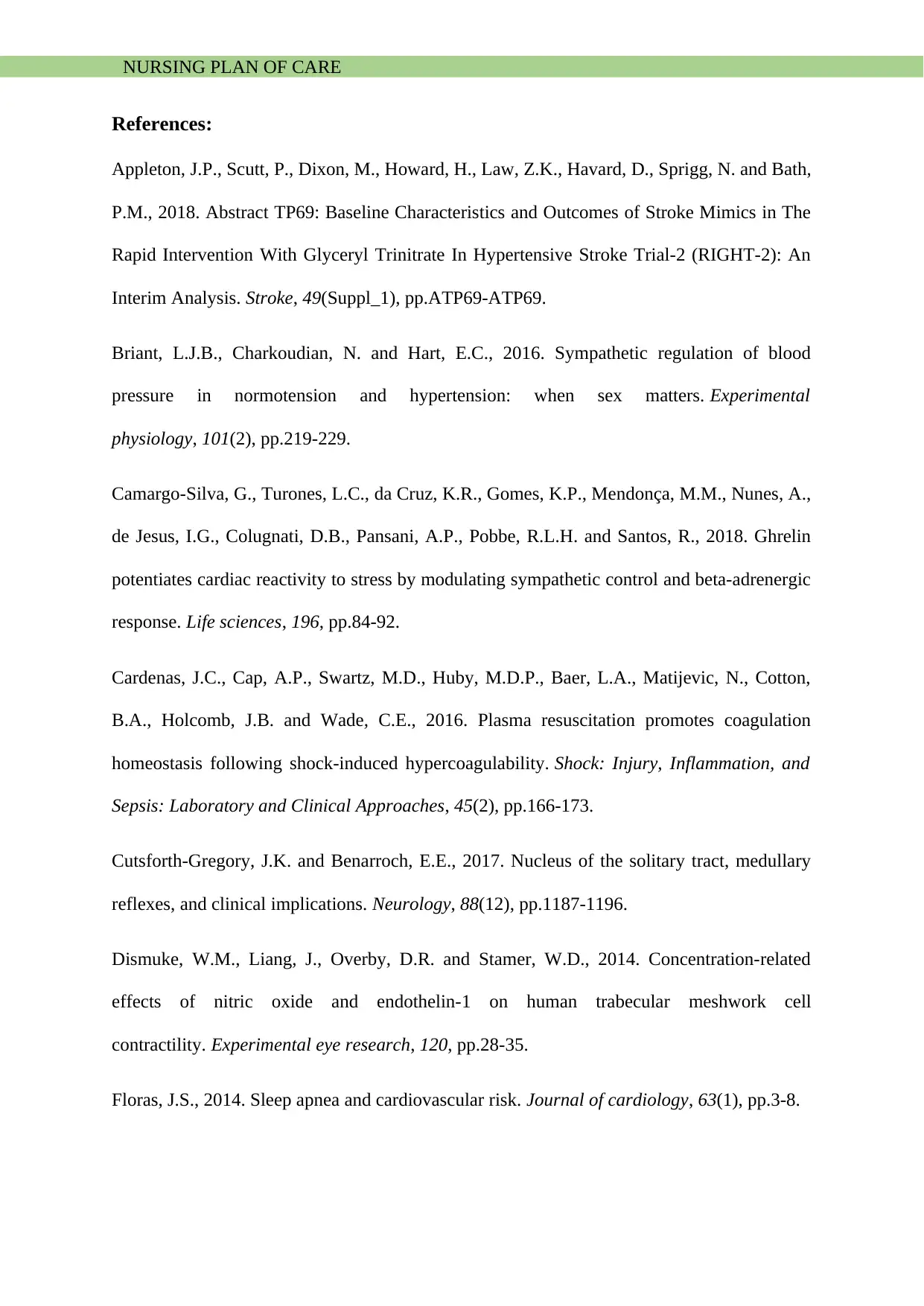
NURSING PLAN OF CARE
References:
Appleton, J.P., Scutt, P., Dixon, M., Howard, H., Law, Z.K., Havard, D., Sprigg, N. and Bath,
P.M., 2018. Abstract TP69: Baseline Characteristics and Outcomes of Stroke Mimics in The
Rapid Intervention With Glyceryl Trinitrate In Hypertensive Stroke Trial-2 (RIGHT-2): An
Interim Analysis. Stroke, 49(Suppl_1), pp.ATP69-ATP69.
Briant, L.J.B., Charkoudian, N. and Hart, E.C., 2016. Sympathetic regulation of blood
pressure in normotension and hypertension: when sex matters. Experimental
physiology, 101(2), pp.219-229.
Camargo-Silva, G., Turones, L.C., da Cruz, K.R., Gomes, K.P., Mendonça, M.M., Nunes, A.,
de Jesus, I.G., Colugnati, D.B., Pansani, A.P., Pobbe, R.L.H. and Santos, R., 2018. Ghrelin
potentiates cardiac reactivity to stress by modulating sympathetic control and beta-adrenergic
response. Life sciences, 196, pp.84-92.
Cardenas, J.C., Cap, A.P., Swartz, M.D., Huby, M.D.P., Baer, L.A., Matijevic, N., Cotton,
B.A., Holcomb, J.B. and Wade, C.E., 2016. Plasma resuscitation promotes coagulation
homeostasis following shock-induced hypercoagulability. Shock: Injury, Inflammation, and
Sepsis: Laboratory and Clinical Approaches, 45(2), pp.166-173.
Cutsforth-Gregory, J.K. and Benarroch, E.E., 2017. Nucleus of the solitary tract, medullary
reflexes, and clinical implications. Neurology, 88(12), pp.1187-1196.
Dismuke, W.M., Liang, J., Overby, D.R. and Stamer, W.D., 2014. Concentration-related
effects of nitric oxide and endothelin-1 on human trabecular meshwork cell
contractility. Experimental eye research, 120, pp.28-35.
Floras, J.S., 2014. Sleep apnea and cardiovascular risk. Journal of cardiology, 63(1), pp.3-8.
References:
Appleton, J.P., Scutt, P., Dixon, M., Howard, H., Law, Z.K., Havard, D., Sprigg, N. and Bath,
P.M., 2018. Abstract TP69: Baseline Characteristics and Outcomes of Stroke Mimics in The
Rapid Intervention With Glyceryl Trinitrate In Hypertensive Stroke Trial-2 (RIGHT-2): An
Interim Analysis. Stroke, 49(Suppl_1), pp.ATP69-ATP69.
Briant, L.J.B., Charkoudian, N. and Hart, E.C., 2016. Sympathetic regulation of blood
pressure in normotension and hypertension: when sex matters. Experimental
physiology, 101(2), pp.219-229.
Camargo-Silva, G., Turones, L.C., da Cruz, K.R., Gomes, K.P., Mendonça, M.M., Nunes, A.,
de Jesus, I.G., Colugnati, D.B., Pansani, A.P., Pobbe, R.L.H. and Santos, R., 2018. Ghrelin
potentiates cardiac reactivity to stress by modulating sympathetic control and beta-adrenergic
response. Life sciences, 196, pp.84-92.
Cardenas, J.C., Cap, A.P., Swartz, M.D., Huby, M.D.P., Baer, L.A., Matijevic, N., Cotton,
B.A., Holcomb, J.B. and Wade, C.E., 2016. Plasma resuscitation promotes coagulation
homeostasis following shock-induced hypercoagulability. Shock: Injury, Inflammation, and
Sepsis: Laboratory and Clinical Approaches, 45(2), pp.166-173.
Cutsforth-Gregory, J.K. and Benarroch, E.E., 2017. Nucleus of the solitary tract, medullary
reflexes, and clinical implications. Neurology, 88(12), pp.1187-1196.
Dismuke, W.M., Liang, J., Overby, D.R. and Stamer, W.D., 2014. Concentration-related
effects of nitric oxide and endothelin-1 on human trabecular meshwork cell
contractility. Experimental eye research, 120, pp.28-35.
Floras, J.S., 2014. Sleep apnea and cardiovascular risk. Journal of cardiology, 63(1), pp.3-8.
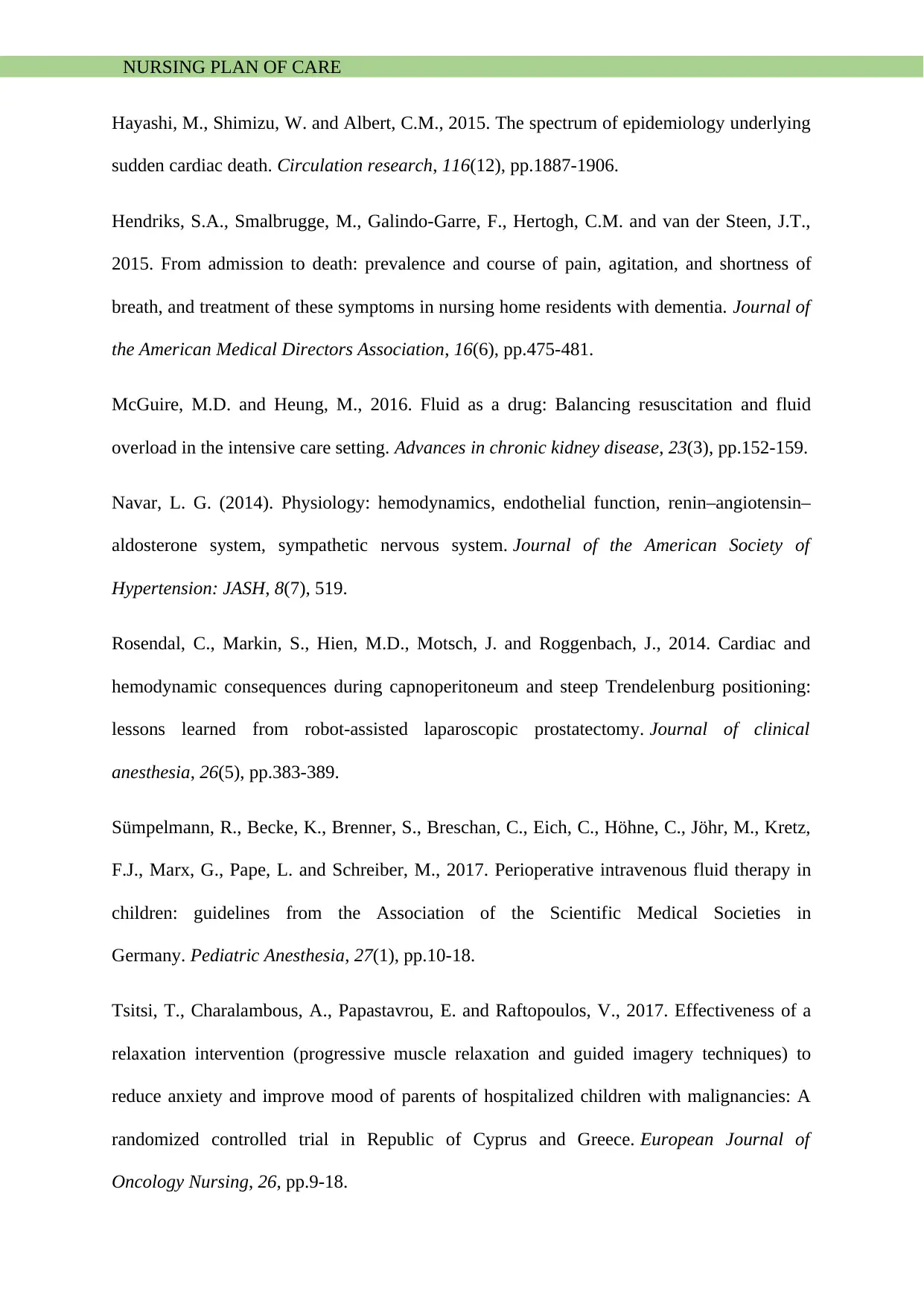
NURSING PLAN OF CARE
Hayashi, M., Shimizu, W. and Albert, C.M., 2015. The spectrum of epidemiology underlying
sudden cardiac death. Circulation research, 116(12), pp.1887-1906.
Hendriks, S.A., Smalbrugge, M., Galindo-Garre, F., Hertogh, C.M. and van der Steen, J.T.,
2015. From admission to death: prevalence and course of pain, agitation, and shortness of
breath, and treatment of these symptoms in nursing home residents with dementia. Journal of
the American Medical Directors Association, 16(6), pp.475-481.
McGuire, M.D. and Heung, M., 2016. Fluid as a drug: Balancing resuscitation and fluid
overload in the intensive care setting. Advances in chronic kidney disease, 23(3), pp.152-159.
Navar, L. G. (2014). Physiology: hemodynamics, endothelial function, renin–angiotensin–
aldosterone system, sympathetic nervous system. Journal of the American Society of
Hypertension: JASH, 8(7), 519.
Rosendal, C., Markin, S., Hien, M.D., Motsch, J. and Roggenbach, J., 2014. Cardiac and
hemodynamic consequences during capnoperitoneum and steep Trendelenburg positioning:
lessons learned from robot-assisted laparoscopic prostatectomy. Journal of clinical
anesthesia, 26(5), pp.383-389.
Sümpelmann, R., Becke, K., Brenner, S., Breschan, C., Eich, C., Höhne, C., Jöhr, M., Kretz,
F.J., Marx, G., Pape, L. and Schreiber, M., 2017. Perioperative intravenous fluid therapy in
children: guidelines from the Association of the Scientific Medical Societies in
Germany. Pediatric Anesthesia, 27(1), pp.10-18.
Tsitsi, T., Charalambous, A., Papastavrou, E. and Raftopoulos, V., 2017. Effectiveness of a
relaxation intervention (progressive muscle relaxation and guided imagery techniques) to
reduce anxiety and improve mood of parents of hospitalized children with malignancies: A
randomized controlled trial in Republic of Cyprus and Greece. European Journal of
Oncology Nursing, 26, pp.9-18.
Hayashi, M., Shimizu, W. and Albert, C.M., 2015. The spectrum of epidemiology underlying
sudden cardiac death. Circulation research, 116(12), pp.1887-1906.
Hendriks, S.A., Smalbrugge, M., Galindo-Garre, F., Hertogh, C.M. and van der Steen, J.T.,
2015. From admission to death: prevalence and course of pain, agitation, and shortness of
breath, and treatment of these symptoms in nursing home residents with dementia. Journal of
the American Medical Directors Association, 16(6), pp.475-481.
McGuire, M.D. and Heung, M., 2016. Fluid as a drug: Balancing resuscitation and fluid
overload in the intensive care setting. Advances in chronic kidney disease, 23(3), pp.152-159.
Navar, L. G. (2014). Physiology: hemodynamics, endothelial function, renin–angiotensin–
aldosterone system, sympathetic nervous system. Journal of the American Society of
Hypertension: JASH, 8(7), 519.
Rosendal, C., Markin, S., Hien, M.D., Motsch, J. and Roggenbach, J., 2014. Cardiac and
hemodynamic consequences during capnoperitoneum and steep Trendelenburg positioning:
lessons learned from robot-assisted laparoscopic prostatectomy. Journal of clinical
anesthesia, 26(5), pp.383-389.
Sümpelmann, R., Becke, K., Brenner, S., Breschan, C., Eich, C., Höhne, C., Jöhr, M., Kretz,
F.J., Marx, G., Pape, L. and Schreiber, M., 2017. Perioperative intravenous fluid therapy in
children: guidelines from the Association of the Scientific Medical Societies in
Germany. Pediatric Anesthesia, 27(1), pp.10-18.
Tsitsi, T., Charalambous, A., Papastavrou, E. and Raftopoulos, V., 2017. Effectiveness of a
relaxation intervention (progressive muscle relaxation and guided imagery techniques) to
reduce anxiety and improve mood of parents of hospitalized children with malignancies: A
randomized controlled trial in Republic of Cyprus and Greece. European Journal of
Oncology Nursing, 26, pp.9-18.
Secure Best Marks with AI Grader
Need help grading? Try our AI Grader for instant feedback on your assignments.
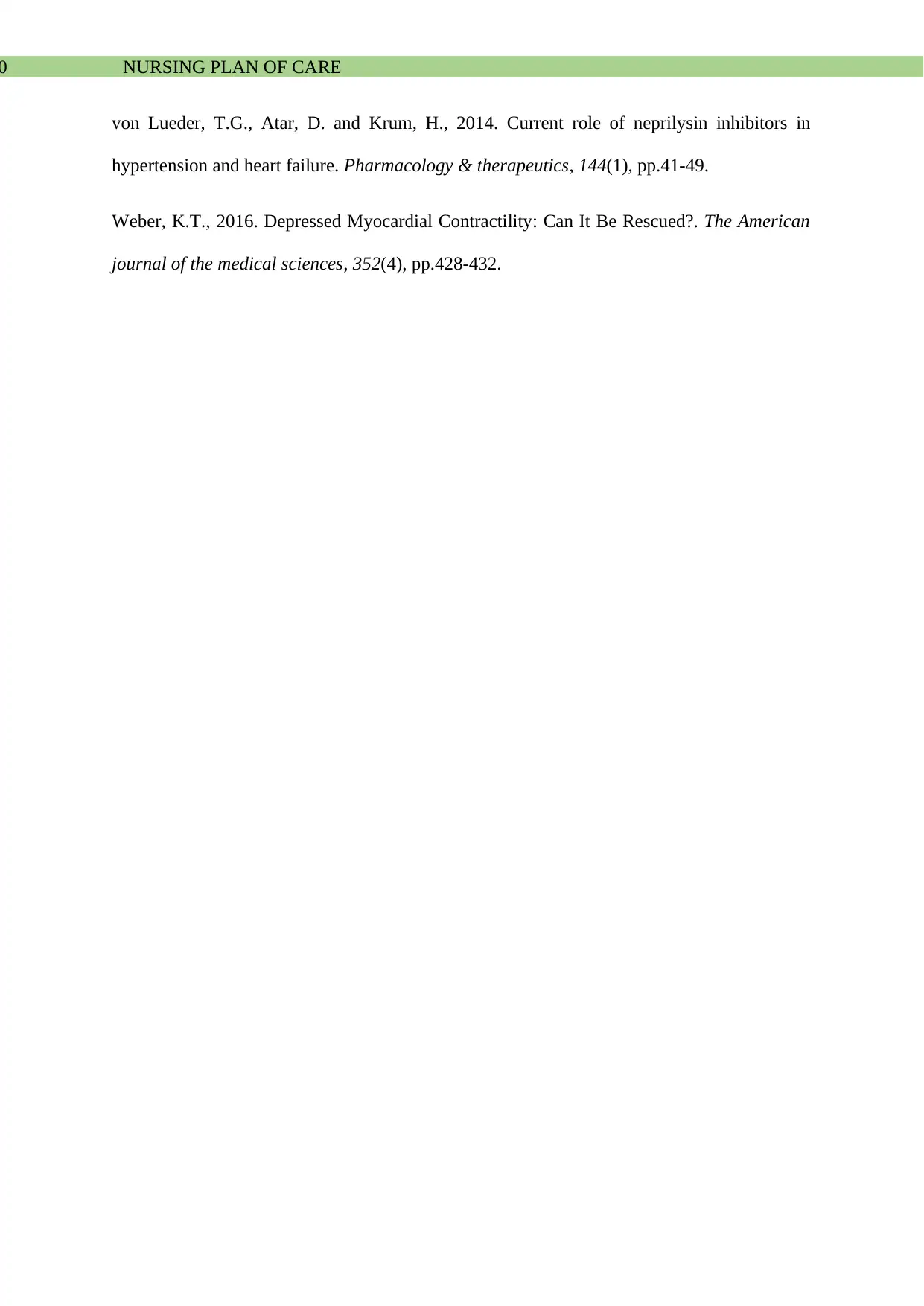
0 NURSING PLAN OF CARE
von Lueder, T.G., Atar, D. and Krum, H., 2014. Current role of neprilysin inhibitors in
hypertension and heart failure. Pharmacology & therapeutics, 144(1), pp.41-49.
Weber, K.T., 2016. Depressed Myocardial Contractility: Can It Be Rescued?. The American
journal of the medical sciences, 352(4), pp.428-432.
von Lueder, T.G., Atar, D. and Krum, H., 2014. Current role of neprilysin inhibitors in
hypertension and heart failure. Pharmacology & therapeutics, 144(1), pp.41-49.
Weber, K.T., 2016. Depressed Myocardial Contractility: Can It Be Rescued?. The American
journal of the medical sciences, 352(4), pp.428-432.
1 out of 11
Related Documents
Your All-in-One AI-Powered Toolkit for Academic Success.
+13062052269
info@desklib.com
Available 24*7 on WhatsApp / Email
![[object Object]](/_next/static/media/star-bottom.7253800d.svg)
Unlock your academic potential
© 2024 | Zucol Services PVT LTD | All rights reserved.





